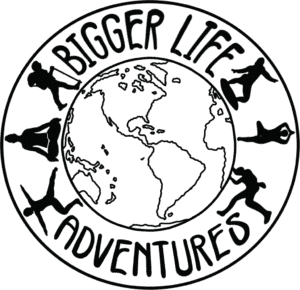A run around San Marcos La Laguna, Guatemala
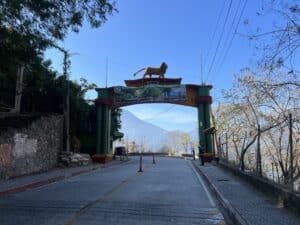
Entrance to San Marcos La Laguna
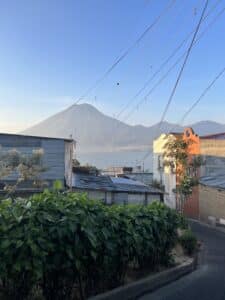
You really can’t tell how steep the roads are in photos.
A run around San Marcos La Laguna, Guatemala
The roads in San Marcos La Laguna are some of the steepest I’ve ever seen. The main road winds around massive Lago Atitlan, a sometimes-paved, sometimes-dirt thoroughfare between water and volcanoes. All other roads ascend steeply and occasionally switchback up into the volcanic hills, wide enough only for tuk tuks, motorbikes, and pedestrians.
This morning, before 7am, I run down the narrow road from our accommodation on the hill towards the lake. Fluffy, well-fed street dogs lounge sleepily on doorsteps. They seem happy and undisturbed by my presence, or just unwilling to wake up early to bark at me. I’ve seen many neighbors feeding many dogs out on this road, so they are homeless but taken care of by the whole village. It looks to me like the best life ever for a dog. Is this true freedom?
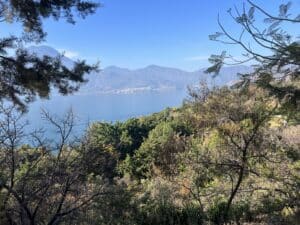
Reaching the main road, I loop east around the lake. Its hilly but inspiring running, beautiful views with only occasional dust kicked up by a passing vehicle or motorbike. Following an AllTrails route, I turn towards the mountains and navigate through another tiny lakeside town, Tzuzuna. Locals are out and about, starting their days, and I don’t see any other tourists. It’s rude not to greet people here, so I do my best to meet the weird “Who are you and why are you running?” looks with an, “Hola, buenos dias.” Women here still dress traditionally in bold Mayan textiles, patterns on patterns on patterns. I’m in love with the style. Men wear cowboy hats and carry machetes or construction tools. Most people are shorter than me, many abuelos and abuelas are not even 4.5 feet tall.
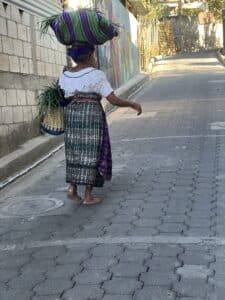
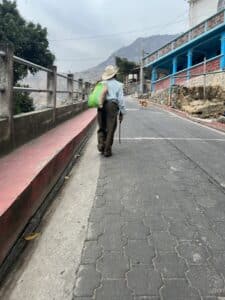
As I wind up the narrow, steep roads from the town center towards farms and neighborhoods, my run turns to a hike. Even in dry season the landscape is green and flowery. It appears anything will grow here, in the fertile volcanic soil. Every produce stand offers a rainbow of fruits and veggies. Avocados nearly the size of my head cost 40 cents. There’s unlimited water, pumped up from the lake in simple PVC pipes, just like our off-grid plumbing at home.
Kids carrying backpacks are walking down the hills to school. They return my greetings with wide eyes and curious, shy smiles. I’m feeling high, not just on altitude, but on life and love and beauty. Wishing the kids “Ten un buen dia” and watching their giggly reactions to the gringa speaking Spanish fills my heart with wholesome satisfaction. The old “White Savior” instincts kick in and I wish I had some stickers to give them. Then, on second thought, it seems these kids need nothing.
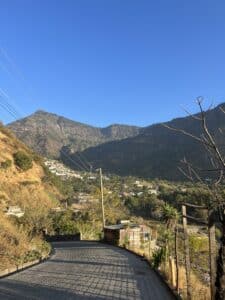
Leaving San Marcos and entering another small village
What is poverty, actually? These kids have water, power, food, pets, and friends to walk to school with. A beautiful place to live. They don’t have phones, school buses, mansions, and helicopter parents worrying about their every move. The answer, of course, is somewhere in the middle. There are different types of poverty and hunger. In the countries with economic wealth we are hungry for nature, connection, and time off. Here in Guatemala, community bonds remain strong, however these sweet kiddos will likely grow up to face sexism, racism, and economic barriers due to government corruption. 100 kilometers away from this lakeside paradise, in the capital city, there is both ridiculous affluence (the wealthiest 10% of Guatemalans own 50% of the nation’s resources) and atrocious violence (gangs, drugs, super-high murder rate). Once again, the light and the shadow coexist and contrast each other, side by side.
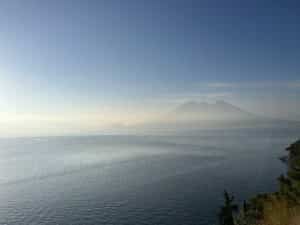
A view of Volcan San Pedro from across Lake Atitlan.
To think that local life at the lake is pure, beautiful, simplicity is naive and too easy of an answer. People are working hard, physically, in a way most office job Americans cannot conceive. As I run/hike these steep trails for my workout, men dig ditches or build houses by hand with local timber and concrete. Women, even old grannies, are mostly working with kids and food, selling veggies, feeding chickens, or carrying baskets of supplies on their heads to and from home, up and down the hills. Everyone here is FIT, with muscular calves and shoulders from hard work and walking. As I ascend a rocky, dirt trail towards the top of the ridge and the end of my route, tin shacks cling to the ledges and laundry on clotheslines strung between trees flaps in the breeze. The kids are real surprised to see me up here! I almost make it to the top before a couple farm dogs burst out from behind a tin wall, angry at my intrusion. You can tell how often strangers pass by how the dogs react. “Para! Esta bien!” I yell at them, reverting to basic phrases as the adrenaline rises. Most of these dogs are all bark and no bite though, so once I turn around and give up the summit it’s all good.
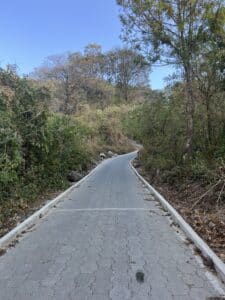
Going up into the farmland
The raw beauty and spirit of this place does give me something I need, some prana that I didn’t even know I was missing. As I run home past gardens, shops, and fenced-off hotels I ponder the simple life — a place where food grows, where things are built by hand, where there’s a lake to jump into every time I’m sweaty. But this place is not mine, and I’m changing it with my very presence. I wonder what life was like here for the Mayans before the Spanish, the Catholics, the travelers, and now the new wave of colonialist yogis. I wonder how they see the growing enclave of yoga shalas, cacao facilitators, questionable shamans, and foreign-owned businesses capitalizing on every type of healing hippie backpackers might possibly be convinced they need. Some digging reveals that the most popular, Instagrammable, yoga retreats here pay their local workers minimum wage ($1.50 per hour) while charging $20 per yoga class and purposely creating barriers between their guests and those whose land they are on. I will stick with my less-traveled trails, my self practice, and daily money spent at the market in an effort to ease my guilt a bit.
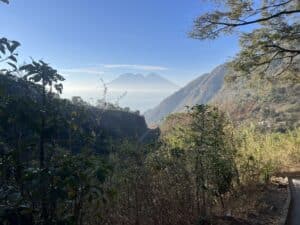
But I’m still here, an American with means who traveled south to find something we lost long ago back in the States. As I hike back up the hill through the barrio my legs are tired, my heart is full of gratitude, and my brain is spinning with questions. Should I be here or not? What impact am I having? These are the questions all travelers and retreat leaders should ask but many don’t. Maybe I will bring people here someday to see this paradise for themselves. And maybe I shouldn’t and won’t.
